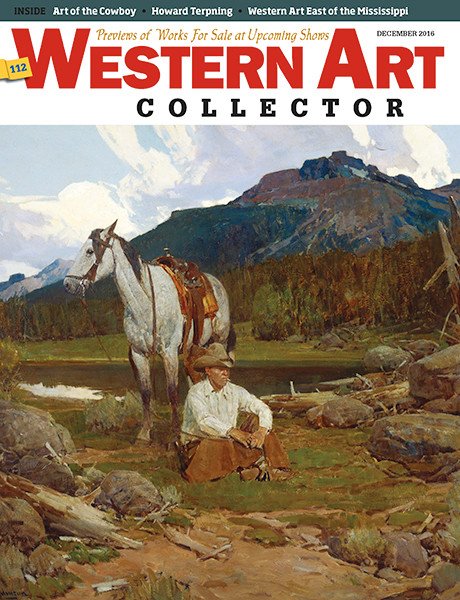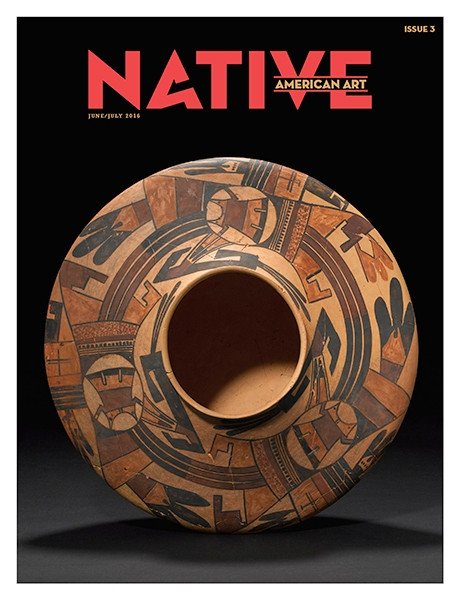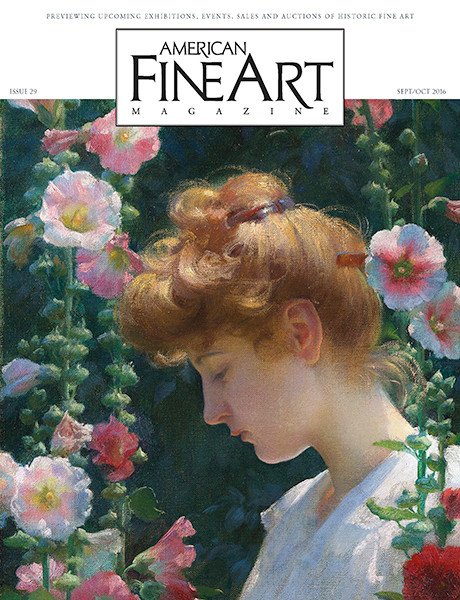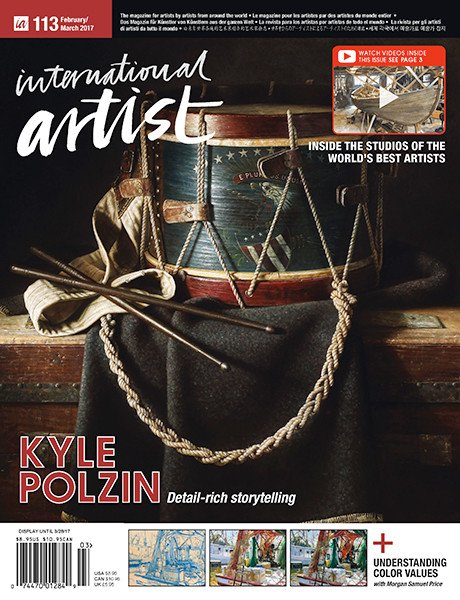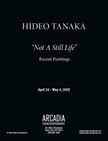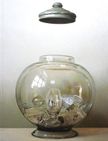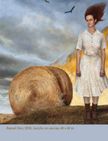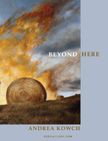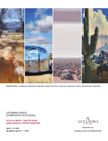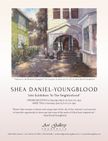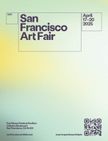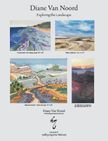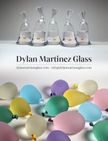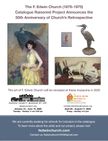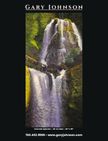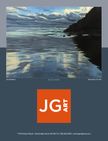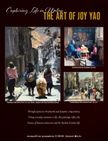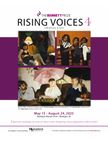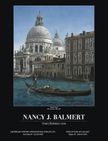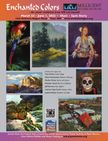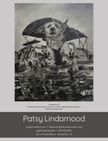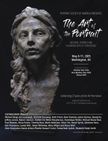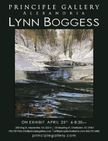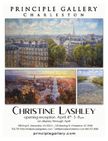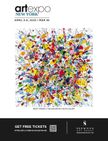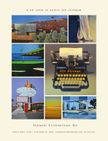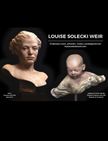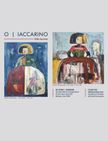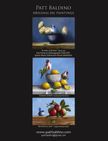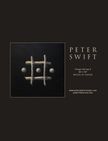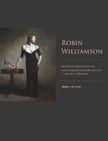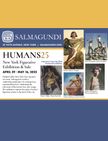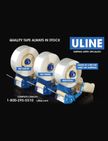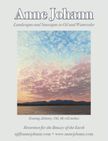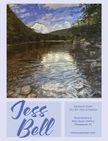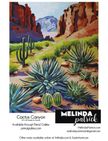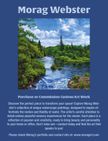There is a lot of controversy—and trepidation—around artificial intelligence and its implications for humanity, including creativity and the arts. And for good reason. But before we begin to explore the newest work by British artist Ben Ashton, let me assure you that his oil paintings are not AI generated nor do his canvases incorporate any digital media. However, his experimentation with AI technology, and the results it yielded, did provide reference material for his latest series, titled Or You Could Panic, now on view at Corey Helford Gallery in Los Angeles through April 19.

Ben Ashton in his studio. Photo credit: Fiona Garden.
Interested in exploring his own ambivalent feelings about AI, Ashton developed several private learning models trained entirely on photographs of his own paintings, countless hand-made costumes, and hundreds of images of himself, his wife and their son, who have been the primary subjects of his portraits for many years.
“It’s important to note that these data sets are like ‘walled gardens,’ based solely on the images that I have fed into them,” says Ashton. “In a way I have created a separate brain that can reimagine elements of everything I’ve ever done…In this way, [I] met new versions of us, often younger and more ideal, imagined characters who are at once unmistakably us, and yet entirely fictional…A distillation of everything that makes us ‘us,’ and yet nobody at all. As I have for years used my family as characters in my work, documenting them as they age and evolve, this interrupts an established delineation in a very subtle and uncanny way. The lines between each character have become blurred, each figure is a combination of all three of the members of my family. This gives the protagonists in these paintings an uncanny appearance—they bear an unmistakable resemblance to us but they are deeply not.”

Or You Could Panic, oil on panel, 45 x 32"
He then used these novel mash-ups of people and clothing (and therefore historical eras) as a jumping-off point for his latest series of glitchy portraits, an interesting, if unsettling at times, process that has ultimately left the artist with more questions than answers—and a body of work that is both brilliant and bewildering.

Shifting Ones Position, oil on panel, 26 x 22"
“Initially I found using the models I made quite exhilarating—although there were obvious limitations to the ability to recreate some human features, the uncanny resemblances to my family were intriguing,” Ashton explains. “The fact that the results don’t appear to be inhibited by real world laws of physics means that some of the output simply could not exist in reality, and I found those results extremely amusing. Costumes would seem lopsided and overly buoyant, feathers and flowers melded into one another and there might be too many hands with not enough fingers. They can also seem genderless because of this lack of consistency. I feel these characters are pulling closer to the inevitable singularity and while I love them because they are us, I slightly fear them because they are not.”
Ashton taught himself to paint from ancient manuscripts and by studying the works of the Old Masters, and at his core is dedicated to mastery of craft and a style of portraiture rooted in the classical tradition. Although this is the first time Ashton has explored AI as part of his painting process, the intersection of art and technology has long been a subject of interest to him.

Swipe Right, oil on panel, 47 x 32"
“I have always been taken by the influence of science and technology on the many leaps made in representational painting from the Renaissance to the modern day,” says Ashton. “Originally there was little distinction between scientific exploration and artistic experimentation, as seen in the work of Davinci, Holbein and so many others, and artists have always been at the vanguard of collaboration with advances in technology. From the very beginnings of my practice I have been incorporating and exploring various technological interventions. From the first explorations with lenses and camera obscura as discussed by Hockney in The Secret Knowledge, I have endeavored to understand how the masters worked alongside advances that affected their lived world. Science has always been indivisible from every aspect of our lives, and art is no exception.

Between the Bars, oil on panel, 37 x 29"
“It is that anxiety about the world I inhabit and that lineage of experimentation that has catalyzed this collection of works—with the fear we all feel around the unchecked advance of technology, and in particular AI and its effect on the creative world, I felt compelled to explore the threat. Or You Could Panic speaks to the futility of fear in a time when it is arguably the most rational response.”
The title piece of the show, and what inspired the ensuing series, contains a combination of different background scenes from earlier paintings of Ashton’s influenced by French painters Jean-Honoré Fragonard and François Boucher. “The closer you look, the less it makes sense,” he says. “The figures are mangled together, a nonsense of writhing flesh.” A similar unraveling effect takes place across most pieces in the show.
On another level, the paintings that comprise Or You Could Panicare simply an extension of Ashton’s life-long examination of the socio-political underpinnings of historical portraiture, this time pushing his use of distortion even further to upend the immortalized over-inflated egos of the elite.

Cavalier Attitude, oil on panel, 37 x 30"
Ashton says, “In the storied tradition of portraiture, my work has always mangled technology together with mastery of paint, and in this series I have delved further and further into disruptions as a means of subversion, introducing inflexible distortions that seek to make a mockery of the subject and their self importance.
“I am fascinated with the historical influence of traditional and ‘swagger’ portraits and how they afford their subjects an air of aloof authority long after their contemporary contexts have been made obsolete, and it amuses me to turn that on its head.”
Because AI shuffled all the visual information Ashton poured into the learning models, this series of portraits is not tied to a particular era of history, as is usually the case. Rather, elements in a single painting often span the 1500s to the 1800s.
“Normally when I begin a series I focus on a specific era of history, usually as a way of drawing comparisons with current events and the cyclical nature of history,” he says. “This time however, I wanted to convey the breaking down of context inherent in the use of AI—how all of history can get mangled together and how the idea of civilization can come unraveled. The costumes in particular are very confusing, for example, combining a Georgian military jacket with a flamboyant floral hat from the Rococo period—all elements pulled from real world costumes I have made for previous work.”
In addition to creating his own costumes using recycled materials like paper for an Elizabethan ruff, or spray-painted trash bags and cardboard for an elegant gown, Ashton also hand-shapes his canvases to allow him to extend his distortions beyond the canvas.

Hello Sailor, oil on panel, 36 x 28"
Ashton is among a growing number of representational artists introducing abstract elements into traditional realism. The phenomenon has been the subject of two books by John Seed, and Ashton was featured in the latest title, More Disruption: Representational Art in Flux.
“Seed suggests that work created now in the relentless bombardment of visual stimulus in the age of the internet has been forever changed,” explains Ashton. “We still have ties with the era of historical realism but we can’t ignore what’s going on right now.
“I can’t speak for anyone else but the distortions I bring to my work stem largely from my anxieties about living in this age. I seek to break and subvert what I consider dear to me, as a way to express my discontent with our current situation. I have spent years learning this craft, committing myself to it everyday in order to master it—I can’t think of a better way to show my dissatisfaction than destroying what I love.”

Opulent Evisceration, oil on panel, 37 x 30"
Ashton’s outlook on what the Pandora’s Box of AI will mean for the future of society and culture, is grim with a silver lining of hope, noting that he is glad he worked with a still-flawed AI, anticipating that its negative impacts will magnify exponentially as the technology is perfected and developed.
“It’s hard to see too far into the future, especially the future of art,” he says. “Artists take immense pleasure in reacting against what is going on in art—as Clement Greenberg was putting Abstract Expressionism on its pedestal, he wasn’t expecting Pop Art to come around the next corner to knock it off.
“I have no doubt that while AI will have its effect on art that is created now, there will be work produced in response that completely opposes all things AI—we can count on the art world to do this.
“Like all Big Subjects, I’ve gone in with one question and I’ve left with a hundred more. I do know that AI certainly won’t become a constant of my practice in the future— I enjoy tactility and thrive on process too much to relinquish it to robots.” —
Ben Ashton: Or You Could Panic
Through April 19, 2025
Corey Helford Gallery
571 S. Anderson Street, Los Angeles, CA 90033
(310) 287-2340, www.coreyhelfordgallery.com
Powered by Froala Editor
